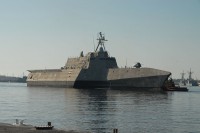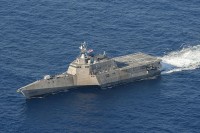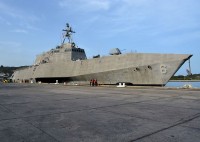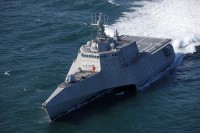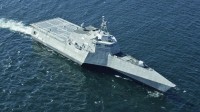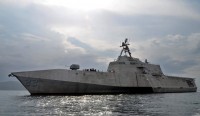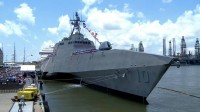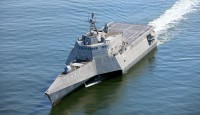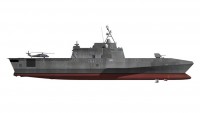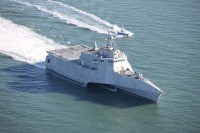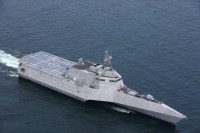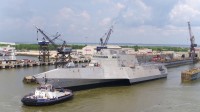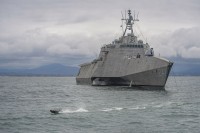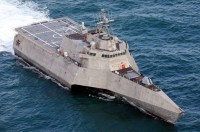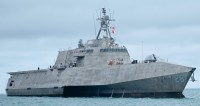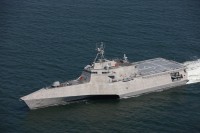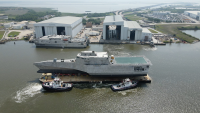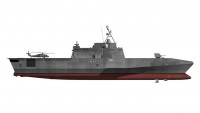Кораблі прибережної зони класу «Індепенденс»
Основна інформація
Головні розміри
Машина
- 2 * General Electric LM2500 gas turbines
- 2 * MTU Friedrichshafen 20V 8000 Series diesel engines
- 2 * American VULKAN light weight multiple-section carbon fiber propulsion shaftlines
- 4 * Wärtsilä waterjets
- 1 * retractable bow-mounted azimuth thruster
- 4 * diesel generators
Персонал
Бойові сили та засоби
- SAAB AN/SPS-77(V)1 Sea GIRAFFE 3D air and surface search radar
- Sperry Marine BridgeMaster E navigational radar
- AN/KAX-2 electro-optical sensor with TV and FLIR
- Northrop Grumman ICMS (Integrated Combat Management System)
- ITT Corporation ES-3601 ESM system
- 4 * SRBOC decoy launchers for chaff and infrared decoys
- BAE Systems NULKA active radar decoy system
- 1 * BAE Systems Mk 110 57 mm gun
- 1 * 11 cell Raytheon SeaRAM CIWS
- 4 * .50-cal guns (2 aft, 2 forward)
- 2 * 30 mm Mk44 Bushmaster II guns (part of SUW module)
- 24 * AGM-114L Hellfire missiles (planned part of SUW module)
- Other weapons as part of mission modules
- 1 * MH-60R/S Seahawk
- 2 * MQ-8B Fire Scouts or 1 * MQ-8C Fire Scout
The Independence class is a class of littoral combat ships built for the United States Navy.
The hull design evolved from a project at Austal to design a 40 knot cruise ship. That hull design evolved into the high-speed trimaran ferry HSC Benchijigua Express and the Independence class was then proposed by General Dynamics and Austal as a contender for Navy plans to build a fleet of small, multipurpose warships to operate in the littoral zone. Two ships were approved, to compete with Lockheed Martin's Freedom-class design.
Despite initial plans to only build ships of the winner out of the two competing Independence or Freedom classes, in 2010 the Navy announced plans to order up to ten additional ships of each class, for a total 12 ships per class. In March 2016 the Navy announced their intention to order an additional two ships, increasing the order to 13 ships of each class.
It was announced in early September 2016 that the first four vessels of the LCS program would be used as test ships rather than being deployed with the fleet. This includes lead ship Independence and Coronado.
As of May 2018, seven ships have been commissioned. Starting in 2019, ships of this class will be designated as fast frigates (FF) which will include increased firepower and heavier armor.
Planning and construction
Planning for a class of small, multipurpose warships to operate in the littoral zone began in the early 2000s. In July 2003, a proposal by General Dynamics (partnering with Austal USA, the American subsidiary of Australian shipbuilder Austal) was approved by the Navy, with a contract for two vessels. These would then be compared to two ships built by Lockheed Martin to determine which design would be taken up by the Navy for a production run of up to 55 ships.
The first ship, Independence was laid down at the Austal USA shipyard in Mobile, Alabama, on 19 January 2006. The planned second ship was cancelled in November 2007, but reordered in May 2009, and laid down in December of that year as Coronado, shortly before Independence was launched.
The development and construction of Independence as of June 2009 was running at more than 3 times budget. The total projected cost for the ship is $704 million. The Navy had originally projected the cost at $220 million. Independence began builder's trials in July 2009, three days behind schedule because of maintenance issues. A leak in the port gas turbine saw the order of trials altered, but builder's and acceptance trials were completed by November, and although her first INSURV inspection revealed 2,080 deficiencies, these were rectified in time for the ship to be handed over to the Navy in mid-December, and commissioned in mid-January 2010.
Navy leaders said that the fixed price competition offered the Austal design an equal shot, in spite of its excess size, cost and limited service. After much inconsistency on how testing and orders were to proceed, in November 2010, the Navy asked that Congress approve ten of both the Independence and Freedom classes.
Design
The Independence-class design began life at Austal as a platform for a high-speed cruise ship. The principal requirements of that project were speed, stability and passenger comfort, and Austal's team determined that the trimaran hull form offered significant passenger comfort and stability advantages over both a catamaran and a monohull. The high-speed cruise ship project evolved into Austal's commercial high-speed trimaran ferry HSC Benchijigua Express. The ships are 127.4 m (418 ft) long, with a beam of 31.6 m (104 ft), and a draft of 13 ft (3.96 m). Their displacement is rated at 2,176 tons light, 2,784 tons full, and 608 tons deadweight. The standard ship's company is 40, although this can increase depending on the ship's role with mission-specific personnel. The habitability area with bunks is located under the bridge. The helm is controlled by joysticks instead of traditional steering wheels.
Although the trimaran hull increases the total surface area, it is still able to reach sustainable speeds of about 50 knots (93 km/h; 58 mph), with a range of 10,000 nautical miles (19,000 km; 12,000 mi). Austal claims that the design will use a third less fuel than the competing Freedom-class, but the Congressional Budget Office found that fuel would account for 18 percent or less of the total lifetime cost of Freedom. The lack of bridge wings on the Independence class had been noted as the top problem in the entire LCS program to the extent that these will need to be retrofitted onto existing ships. The lightweight aluminum construction of the Independence-class ships makes them more vulnerable to damage than the Freedom-class ships.
The first ships of both LCS classes were delivered before the designs were mature so that improvements could be built into future ships. The Navy is improving the Independence-class with bridge wings for safety and replacing the 5.1-metre (17 ft) Rigid Hull Inflatable Boat (RHIB) with a 7-metre (23 ft) boat. An improved cathodic protection system will enhance corrosion protection. Like the Freedom-class, the Independence vessels will be getting axial flow water jets which pushes water parallel to the shaft of the impeller to improve efficiency and reduce maintenance; they will also be upgraded to handle the horsepower provided by the gas turbine propulsion system. A winch control system will modulate the motion of the anchor to reduce the reliance on manual hand brakes. The mission bay side door will be redesigned for reliability and the platform lift elevator reconfigured to better handle weapons and ordnance.
Modular mission capability
The Independence-class carries a default armament for self-defense, and command and control. Unlike traditional fighting ships with fixed armament such as guns and missiles, tailored mission modules can be configured for one mission package at a time. Modules may consist of manned aircraft, unmanned vehicles, off-board sensors, or mission-manning detachments. The interior volume and payload is greater than some destroyers and is sufficient to serve as a high-speed transport and maneuver platform. The mission bay is 15,200 square feet (1,410 m2), and takes up most of the deck below the hangar and flight deck. With 11,000 cubic metres (390,000 cu ft) of payload volume, it was designed with enough payload and volume to carry out one mission with a separate mission module in reserve, allowing the ship to do multiple missions without having to be refitted.
One Mobicon Flexible Container Handling System is carried on each ship in order to move mission containers. In addition to cargo or container-sized mission modules, the bay can carry four lanes of multiple Strykers, armored Humvees, and their associated troops. An elevator allows air transport of packages the size of a 20-foot-long (6.1 m) shipping container that can be moved into the mission bay while at sea. A side access ramp allows for vehicle roll-on/roll-off loading to a dock and would have allowed the ship to transport the since-cancelled Expeditionary Fighting Vehicle.
Armament and sensors
The Raytheon SeaRAM missile defense system is installed on the hangar roof. The SeaRAM combines the sensors of the Phalanx 1B close-in weapon system with an 11-missile launcher for the RIM-116 Rolling Airframe Missile, creating an autonomous system. The Independence-class ships also have an integrated LOS Mast, Sea Giraffe 3D Radar and SeaStar Safire FLIR. Northrop Grumman has demonstrated sensor fusion of on and off-board systems in the Integrated Combat Management System (ICMS) used on the LCS. The vessels have an Interior Communications Center that can be curtained off from the rest of bridge instead of the heavily protected Combat Information Center found on other Navy warships.
Side and forward surfaces are angled for reduced radar profile. The Fleet-class unmanned surface vessel is designed for operations from Independence-class ships. The flight deck, 1,030 m2 (11,100 sq ft), can support the operation of two SH-60 Seahawk helicopters, multiple unmanned aerial vehicles, or one CH-53 Sea Stallion helicopter. H-60 series helicopters provide airlift, rescue, anti-submarine, radar picket and anti-ship capabilities with torpedoes and missiles. DARPA's Tactically Exploited Reconnaissance Node (TERN) program aims to build a Medium-altitude long-endurance unmanned aerial vehicle (MALE UAV) that can operate from LCS-2 and can carry a payload of 600 pounds (270 kg) out to an operational radius of 600–900 nautical miles (1,100–1,700 km). First flight of a TERN demonstrator is expected in 2017. The trimaran hull will allow flight operations up to sea state 5. Austal USA vice president Craig Hooper has responded to critics of the class's light armament by suggesting that the ships employ long range drones instead.
On 19 July 2016, while participating in the Rim of the Pacific Exercise, Coronado was used to conduct a live-fire missile test of a Block 1C Harpoon anti-ship missile. While the missile failed to destroy its target, the test validated the ability to launch high-powered missiles from the forward deck of an Independence-class vessel, which is expected to lead to deployment of Harpoon missiles on future LCS missions.
Кораблі19
- Коментарі
 uk
uk en
en ru
ru
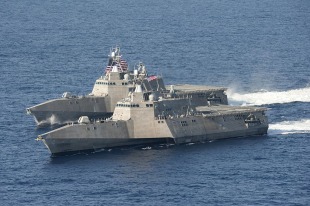
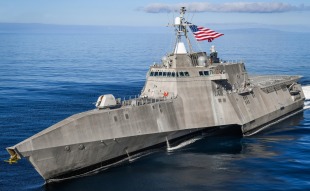
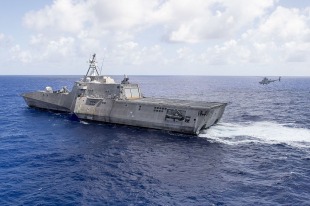
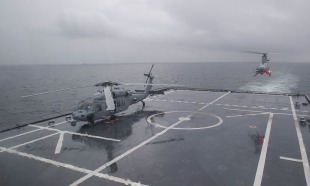
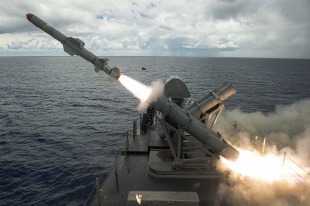
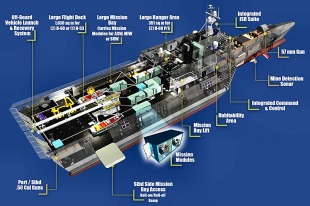
 Військово-Морські Сили США
Військово-Морські Сили США